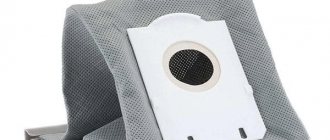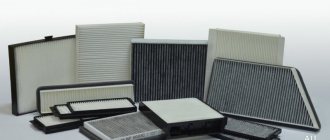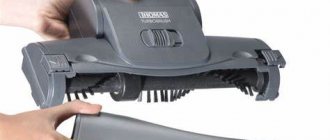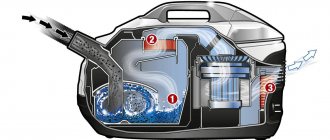For a vacuum cleaner to last for a long time, it needs proper care. Maintaining household appliances is the key to their smooth operation. It is important to know how to clean the vacuum cleaner filter to maintain its suction power for dirt and dust particles. When the cleaning elements become clogged, the power of household appliances drops noticeably; in addition, this creates additional load on the motor of any model.
How to prepare the filter for cleaning
Any algorithm for how to clean a vacuum cleaner filter requires careful preparation of the device for this procedure. It depends on the model of the device, its technical capabilities and even dimensions.
Typically, a vacuum cleaner provides at least 2 stages of filtration - coarse and fine. The first is the collection of waste directly into a dust collector, which includes fabric or paper bags and containers. Next, the air moves to a finer cleaning system - a filter at the outlet of the device, for which manufacturers often install a hepa system. Most modern models are also equipped with an engine compartment filter that prevents clogging. For proper operation of household cleaning equipment, it is important to clean all three filtration elements.
Preparing any cleaning device for filter cleaning should include the following preparatory steps:
- The vacuum cleaner must be unplugged, since disassembling the device while it is on is dangerous. It is advisable to roll up the power cord and place it in the cell provided on the model.
- The vacuum cleaner should be placed on an area of the floor that is free from carpeting. It is advisable to lay down oilcloth or newspaper to avoid excess dust and dirt. It is not recommended to carry out any manipulations “by weight”.
- Remove filters from the device only according to the instructions included with each specific model. It is advisable to clean all 3 filters - the dust bag or container, the filter element of the engine compartment and the fine filter cartridge at the outlet of the vacuum cleaner.
Kinds
Externally, HEPA elements vary in color, shape and structure. The main difference between them is the material. Vacuum cleaner manufacturers produce paper and polymer components. When disassembling devices, they can be easily recognized by their porous structure.
The main difference between filters is their material.
While it is not difficult to clean a HEPA filter from fluoroplastic fibers, in the case of a paper analogue it is better to abandon this idea. If it is very dirty, it should be replaced with a new disposable filter, as the performance of the device may decrease after cleaning.
When purchasing a vacuum cleaner, blower, fan or air conditioner, be sure to check the type of mechanism with the seller. This is also written in the device's operating instructions or on the packaging. As a guide, the manufacturer adds the letter “W” to the model name.
Cleaning the coarse filter compartment
The first step is to remove the device's main dust collector, either a bag or container, depending on the model. At the same time, the algorithm for how to clean the filter of a Samsung vacuum cleaner may differ from a model of another brand, even if they have the same filtration system. It is important to carry out all actions to extract elements according to the instructions.
Modern models are equipped with three types of filters, and the cleaning algorithm for each of them is different.
Extreme cleaning at 430 W. Review of the Samsung SC8835 vacuum cleaner.
I welcome all guests and participants of the CSN expert club!
Today we are reviewing a vacuum cleaner from SAMSUNG. The model in question has an interesting design and an additional compartment in the waste collection container. Vacuum cleaners with a cyclone filter have their pros and cons, which we will discuss below and, based on the tests carried out, we will try to determine how much the functionality of the vacuum cleaner will change due to the improved container system.
It is known that the first vacuum cleaner was invented back in 1860, the design of which was supposed to have two water filters. But this project was never brought to life.
The first implemented vacuum cleaner can be considered the Whirlwind, created in 1869. In the Whirlwind vacuum cleaner, the fan was driven by rotating the handle through a belt drive, while at the same time the vacuum cleaner had to be pushed.
Today, vacuum cleaners can be divided into several types:
— HEPA vacuum cleaners.
This is a vacuum cleaner with a bag, and the outlet has a HEPA filter. The filter is an accordion-folded fibrous material and a housing-frame holding the filter assembly. Vacuum cleaners with such a filter are often used in homes where there are people suffering from allergies and asthma.
— Vacuum cleaners with a water filter.
The air flow with dirt and dust passes directly through the chamber with water. Large debris and large dust particles are wetted and remain in the water. To retain small particles, such vacuum cleaners install a HEPA filter or separator. The separator is a hollow cylinder with blades, rotating at a speed of 25 thousand revolutions per minute, and creates a fine suspension of water and tiny dust particles, which under such conditions are wetted by tiny drops of water and settle on the walls of the separator. The air leaves the separator almost clean thanks to the special shape of the blades. The efficiency of air purification using a separator reaches 99.9991%.
— Vortex or cyclone vacuum cleaners.
They are also called bagless vacuum cleaners. The principle of operation is based on the centrifugal force that acts on the body. A vortex vacuum cleaner is equipped with several cylindrical separator chambers, tapering downward.
— Washing vacuum cleaners.
During cleaning, washing liquid or plain water is supplied to the nozzle. Through the nozzles on the brush, water is distributed throughout the entire working area, wets the dust particles, and excess water is sucked back and supplied to another reservoir of the vacuum cleaner, specifically for waste water.
Cloth or paper bag
Models with such “filters” are especially popular because they are in the middle price segment, are easy to use and last a long time if used correctly.
Paper bags are considered disposable; they are removed and thrown away when filled without opening.
For fabric dust collectors that are reusable, the following cleaning algorithm is used:
- Remove the bag from the plastic holder inside the vacuum cleaner and carefully remove it, trying not to make sudden movements. This will prevent the spread of dust and debris.
- Transfer the bag into a large plastic bag of such a size that the dust container can be turned over and the contents can be poured out.
- After waiting for the dust to settle, carefully pull out the bag, and dispose of the plastic bag with the garbage.
- The bag is cleaned by machine or by hand, depending on the material. The dust collector should be dried naturally on a clothesline.
Most instructions on how to clean the filter of Samsung and other brands of vacuum cleaners do not recommend wet cleaning of the bags. However, it is recommended to carry out this procedure occasionally in order to achieve better cleaning of the dust collector from dirt.
How to clean a cyclone vacuum cleaner | Economical housekeeping
- dry cleaning;
- clean and scent the air;
- clean up small amounts of spilled liquid;
- deep cleaning of carpets using a turbo brush;
- cleaning upholstered furniture and textile surfaces;
- cleaning sensitive surfaces with a parquet brush;
- cleaning hard-to-reach places with a crevice nozzle.
Particularly dirty fabric dust collectors can be cleaned by washing them in an automatic machine . To do this, place the bag, previously cleared of debris and dust, into the washing machine, set the quick wash mode, and add washing powder. After the dust collector has been thoroughly dried, it can be used again for its intended purpose.
Cyclone and water filters
The algorithm for how to clean the filter of a cyclone-type vacuum cleaner differs from models with dust bags. It includes the following steps:
- Remove the container from the vacuum cleaner and shake out any accumulated debris.
- Wash the dust container under running water using plain or laundry soap and rinse thoroughly.
- Turn the container over to drain excess water and, if necessary, wipe with a clean rag.
Models with aqua filters are cleaned in the same way. Manufacturers recommend cleaning cyclone and water models after each use of the device. Otherwise, a significant reduction in suction power may occur.
Prevention measures
extend the “life” of filters in a Samsung vacuum cleaner :
- Do not vacuum surfaces covered with large debris and fine construction dust (this rule will not only help extend the life of the filter elements, but will also protect the household appliance from serious damage);
- you need to carefully ensure that the filter and dust collector are installed exactly in their places (gaps reduce the suction force significantly);
- Cleaning is carried out as carefully as possible, without the use of hard brushes and aggressive household chemicals.
You should not save when buying new consumables for a vacuum cleaner (dust collector, filters). High-quality, original products will last much longer.
Cleaning the motor filter
Depending on the model of the vacuum cleaner, immediately behind the coarse cleaning system there is a filter that protects the device’s motor from contamination. It is usually made of synthetic material or ordinary foam rubber. This filter also requires timely cleaning according to the following algorithm:
- Remove the element from the vacuum cleaner body.
- Carry out wet cleansing with a sponge or under running water using soap.
- Rinse and lightly wring out the filter, dry under natural conditions.
- If there is a plastic mesh in the model, it is also removed from the space around the engine and wiped with a damp cloth.
Step-by-step instructions for complete disassembly
Partial disassembly is performed when replacing or cleaning filters, but in order to remove the engine, it is necessary to disassemble the device completely. We offer detailed photographic disassembly instructions that will help you cope with the repair of the Samsung vacuum cleaner yourself.
Stage #1 - we diagnose the breakdown
When you use one device for a long time, you can perfectly imagine how it behaves during operation.
An experienced user does not need to look at the bag or tank full indicator; it even determines by sound when it is time to empty the dust container or filters. Consequently, he will also determine the fact of a malfunction by the unusual behavior of the assistant.
If an overfilled vacuum cleaner begins to hum or hiss, then a mechanism with a broken motor or board makes intermittent sounds, begins to “spit” dust, smells like burnt wires, or simply does not respond to being plugged in.
If you doubt the serviceability of the vacuum cleaner, you can try to disassemble it. This is a simple procedure that does not require special knowledge or special skills. As instructions, you can use videos or photo instructions from craftsmen, carefully filmed by them and posted on the Internet.
Stage #2 - selecting tools and materials
To disassemble the vacuum cleaner body, you do not need to purchase a special tool. Most likely, a pair of screwdrivers, Phillips and slotted, which can be found in the household of any city dweller or rural resident, will come in handy.
No tools are required to disassemble the filters as this is a regular maintenance procedure. You just have to manually remove the covers or open the plastic boxes.
On some models, to change the HEPA filter, you need to remove the rear grille by unscrewing 2-4 screws, also using a screwdriver.
But if manipulations with the motor, board elements, and wires are to be done, the following tools and materials may be required:
- pliers;
- file;
- awl;
- sandpaper;
- vice;
- construction knife;
- spare connectors and wiring.
Small parts are inexpensive, but a faulty engine requires replacement - an average of 1,650-2,600 rubles.
Instead of an expensive original part, you can look for an alternative mechanism, but you should pay attention to the materials from which it is made
Stage #3 - disassemble the vacuum cleaner body
It often happens that during the process of disassembling the device there is a problem, that is, the cause of the breakdown is not necessarily a failed engine. The thermal relay connector may have come loose or there may be damage to the board.
All actions can be performed by an untrained person, since disassembling this model requires attention, accuracy and the ability to use screwdrivers - flat and Phillips
A vacuum cleaner is one of the most common household appliances and is found in every home. Being an indispensable assistant in cleaning premises, the unit itself also requires constant care. Therefore, the quality of cleaning and the service life of the device depend on how correctly and timely its cleaning is carried out.
Cleaning the filter at the outlet of the vacuum cleaner
The fine cleaning system at the outlet of the vacuum cleaner also requires timely maintenance. The cleaning algorithm depends on the filter material and device design.
If the element is made of foam rubber, then it is simply washed with soap and water and dried under natural conditions. It is not recommended to dry on radiators of the heating system, as excessive heating will cause deformation of the material.
Models equipped with a Hepa filter require a different approach to cleaning:
- The element is removed from the device body, placed on a flat surface and lightly patted on it to shake off dust particles.
- Dip the hepa filter accordion side down into the soapy solution for 20 minutes.
- Gently wash the element with your hands; rubbing it with a brush or sponge is not recommended, as this will lead to damage.
- Rinse the filter and place it on a piece of cloth to dry, which may take several hours due to the multi-layer nature of the element.
The hepa filter should be cleaned no more than once a year. Some models require its complete replacement after a certain time specified in the instructions.
There are no complex algorithms in the procedure for cleaning the vacuum cleaner filter; any user of household appliances can perform this process independently. The main thing is to take into account the design features of the model and follow the manufacturer’s instructions attached to it.
How to empty a vacuum cleaner's dustbin - Your guide to choosing a vacuum cleaner
- First of all, you need to turn off the power to the device and wind up the cord (as a rule, this is done automatically on modern vacuum cleaners).
- It is advisable to clean the vacuum cleaner outside or on the balcony.
- Disconnect the brush and hose and try to clean their internal cavity as much as possible.
- Open the vacuum cleaner body and carefully remove the dustbin.
- Remove all existing filter elements and clean them (each type has its own processing method, we’ll talk about this in more detail below).
- After completing the processing procedure for all removed elements, all parts should be returned to their original places. The device should be stored in a place that prevents accidental mechanical damage.
To prevent the filter in the vacuum cleaner from becoming a breeding ground for bacteria and fungi, it must be cleaned promptly. The dust collector (bag, container) is cleaned as it fills with debris (the indicator on the body of the vacuum cleaner will tell you when exactly it needs to be cleaned).











